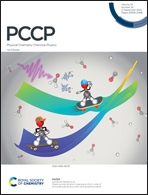Phase separation in bismuth doped Mg2Si0.5Ge0.5 thermoelectric alloy
Abstract
Phase separation by the spinodal decomposition or nucleation and growth mechanisms is an established method for the generation of thermodynamically stable sub-micron features, capable of both reducing the lattice thermal conductivity, κl, and stabilizing its value, while obtaining high and stable thermoelectric (TE) figure of merit ZT values during practical applications. In the Mg2(Si,Sn,Ge) class of TE materials, a miscibility gap and a thermodynamic tendency of phase separation were reported in the Mg2Si–Mg2Sn quasi-binary section of the ternary phase diagram, capable of enhancing and stabilizing the TE performance, by κl minimization. Yet, no such tendency was ever reported for the Mg2Si–Mg2Ge quasi-binary system, prohibiting the fulfillment of its TE potential. It is currently shown that a similar (yet, less pronounced) tendency of phase separation is also apparent in the Mg2Si–Mg2Ge quasi-binary system, into Mg2Si- and Mg2Ge-rich Mg2Si0.5±δGe0.5±δ phases. This phenomenon is enhanced upon bismuth doping. Upon 1.5, 2, and 2.5% bismuth doping of Mg2Si0.5Ge0.5, following induction melting and hot-pressing, the solubility limit of Bi was found as 1.5–2%, while increasing the bismuth content resulted in significant Mg3Bi2 segregation into grain boundaries. The combined phase separation and segregation effects on κl reduction with the electronic effect of Bi doping resulted in a reasonably high maximal ZT of 0.9, which was observed upon 2.5% Bi doping.



 Please wait while we load your content...
Please wait while we load your content...